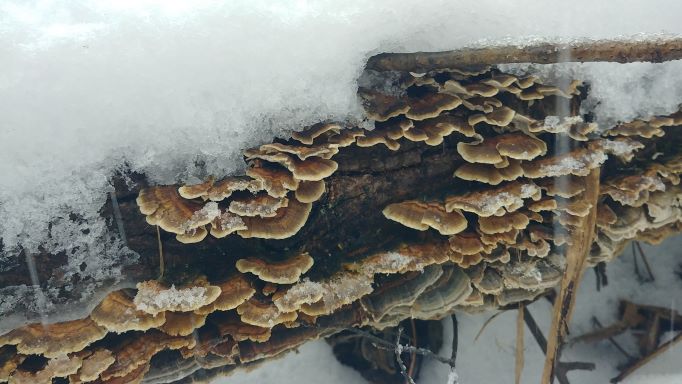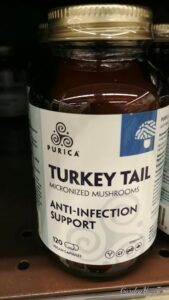No matter where in the world you're you always have a chance to appreciate your ecological environment. And I don't find a better way to adore your surroundings than diving into nature and finding flavourful delicious gifts that are waiting for us.
Wherever you’re in the world, for example, I’m at 49.8 degrees of N latitude and 59,7 W longitude now.
Even when there’s essentially nothing growing in your ground look what you preserved in your cellar, what have you managed to get canned and frozen. The good news is that there are more than that outside in nature.
When you keep yourself open to experiments in applying the pieces of nature into your food you create hyper-seasonal cooking for yourself and your family.
Let’s continue our trip to the wilderness (read about the first part here) and research two remaining treasures that you can bring to your table and enjoy the flavors of nature.
4. Turkey Tail Mushrooms (Coriolus versicolor)
I’m in this area, probably a 10 min walk from where I was shooting the video about high bush cranberries and I was looking for these treasures which are not easy to find because of the snow but I was lucky enough to discover turkey tail mushrooms.
When you look from the top they look exactly like turkey tails.
How would you identify them first of all?
By a very picturesque and bright ornament on the top.
On the bottom, they should have pores, not accordions but the pores, very tiny pores that’s how the typical turkey tail mushroom looks like.

And surprisingly enough, no matter they look so small, you can still apply turkey tail mushrooms in your cuisine!
You can cook soup from the fresh turkey tail mushrooms as soon as you bring them home.
You can dry turkey tail mushrooms, store in a glass jar and cook from the dried ones, when you dry them out you grind them into a powder and apply that powder into your daily dishes: smoothie, cereal, porridge and sprinkle it over your salads too.
So where to find the turkey tail mushrooms?
On the old trees that have fallen down and laying dead for quite a while. I mean several years old trees.
I could not wait and tasted these fresh mushrooms. I realized that you can easily enjoy the flavors of the turkey tail mushrooms right away when you chew them, however, they are quite hard to chew. They are good to use as chewing gum by the way.
When you chew them you feel the natural mushroomy flavor of the real mushroom.
As I mentioned before, do not pick those mushrooms that look similar in shape and form as turkey tail ones. Those are rather monotone in the color pattern on the top and they have bigger pores on the bottom. So they are not real Coriolus versicolor.
Now I’d like to display the palette of their décor. You can find them colored as light as this and let me pick an example from here. Same structure but much lighter because this place is exposed most to the sun. And when we follow along the log we approach this spot with the most colorful species and when I slide along here you can see how the pattern changed to be more green-ish and silver-ish.
You can read more about identification of turkey tail mushrooms here.
“Numerous studies have shown turkey tail extract improves survival rates for gastric, breast, and colon cancer.” *
Here is how natural medicine benefits your health: when you eat turkey tail mushrooms you enhance your body with antibacterial and antiviral properties. No doubt why you might see medical supplements in your local natural food store made with turkey tail mushrooms.

5. Juniper Berries
Now I’m with you to discover this last treasure for today.
Look at this weather here around the town. But please, weather, let me finish my edible walk by introducing you to the juniper berries.
January or February is the best time to enjoy the juniper berries because that’s when (I believe) they become the most potent and most ripened.
You can identify them by this blue with silver coating.
Later on, when the spring approaches the berries will get dropped from the branches.
Earlier in the fall, they had not ripened yet but I’ve seen a recipe where you can apply green unripened berries and use them to your advantage in your cuisine.
I enjoy their flavor so much! The flavor could be described as a sweet mix of conifer resin and forest.
How would you apply juniper berries in your cuisine?
- I cooked rice with juniper berries, the same as Persian people do with raisins or barberries. Barberries are very traditional in Persian cuisine as an addition to the rice so I added the juniper berries and the rice came out pretty flavorful.
- Add a dozen or so berries (and perhaps a green juniper twig or two) to the stewing mix when you cook your steak until tender. This works nicely with lean beef, which you can then serve as moose to unsuspecting guests.
- It’s also nice to make a bed of juniper twigs to put your fresh and freshly gutted wild salmon on before you bake it in the oven. Put a bit of dill and salt, pepper, and lemon juice inside, and add some lemon and salt on top, too. Serve when done. Yum!
- Juniper berries impart a peppery taste and flavor to dishes. In fact, dried berries were commonly used in place of black pepper when the latter was very expensive. Ripe berries are used in cooking and flavoring because they don’t have much of the turpentine-like taste of the green berries.
- The peppery flavor of juniper berries goes very well with pickled vegetables and soups. In fact, I have applied them to sauerkraut before. You can either use fresh berries or dried ones, but crushing them with a pestle or mortar helps release the flavors. Since dry berries have a milder flavor, you need to use more.
- A fermented Bosnian drink called Smreka can be made from juniper berries and plain water. Add 1 cup of berries to 2 quarts of water and allow to ferment for a week or more. The drink is ready when all the berries sink to the bottom. Strain the liquid and drink it lightly sweetened with raw honey if you like.
- They can also be used in sweet dishes such as fruitcakes.
So pretty much it’s up to you to use your imagination on how you can combine the flavor of the juniper berries with your meals.

Speaking from a medicinal point of view they are known for:
– releasing the acidic toxins from your body;
– relieving urinary tract problems;
– old-time treatment for gout;
– help in improving digestion;
– help in getting rid of excess fluid from the body.
I’ve learned that not all of the juniper berries are edible. And honestly, not every juniper you see around will be producing berries. You have to approach the bushes very close to see the berries on them because they’re not visible from a distance.
The following juniper species are edible:
- Juniperus communis
- Virginia juniper (J. virginiana)
- The Rocky Mountain species (J. scopulorum)
- Utah juniper (J. osteosperma)
- Western juniper (J. occidentalis)
- Southern redcedar (J. silicicola)
- Seeded juniper (J. monosperma)
- J. drupacea
- J. phoenicia
- Alligator juniper (J. deppeana)
- J. californica – eat with a caution
However:
You should never eat the berries of Juniper Sabina or as it’s also called Savin Juniper. If the oil from Savin Juniper is ingested the outcome could be fatal. Ingested in small amounts can in the best case result in irritation of the mouth, diarrhea, vomiting, pain in the stomach, and colic.
There are a few other species of Juniper that should be avoided altogether because of the possibility of toxicity like:
- Juniperus polycarpus,
- Juniperus thurifera
- The cade plant (J. oxycedrus)
Learn more about junipers from Kristine Lofgren on Gardener’s Path. **
Here is what I do when I see an unknown berry and would like to taste it.
As soon as I feel any unpleasant taste I just spit it out. Spit it out and then collect some saliva in the mouth, spit it out, and clean the mouth this way.
Even if you get a minimal amount of the toxins in your mouth you spit it out right away.
If you have some drink with you, just rinse your mouth and spit it out. You will not get poisoned from one random berry that you might have bitten on your wild edible walk.
Enjoy your time in nature, collect juniper berries, and if you have any doubts about the plant or part of the plant that you can see in nature and have a doubt if it’s edible or not feel free to send me a message. Write a comment below this video and let me know how I can help you out so that you will be more comfortable in eating wild edibles, enhancing your meals with the wild nutrients, and enhancing your immunity.
We are all the parts of nature, same as they are, that’s how our relationship works out. As you can see we consist of the same chemical elements as they do.
Every wild edible plant possesses immune-supporting capabilities. This is a proven fact that wild plants survive all of the weather conditions. They lived through conditions of the viruses that fly around, conditions of the possible contaminations as well as conditions of the pollution experienced over the last hundred years.
They already hardened themselves enough to survive. They have very strong immunity by themselves so when you eat the pieces of wild plants you strengthen your own immunity as well.
Every season I regularly sneak into nature to discover hidden wonders of wild edibles. No matter what season or what climate zone you’re in you can forage for wild edibles all the time.
If you’re asking why I started to do that… Well…
The seasonal flavors inspire me to explore nature, to get attached to the land we live on. When we roll through the seasons we always have a chance to appreciate our local environment. And I can’t find a better way to adore our ecological landscape than exploring and devouring flavourful gifts that are waiting for us out there.
I honestly believe that when we add wild foods to our cuisine we become closer to mother nature, and this way we become more independent, self-sufficient, and self-reliant.
And when I share this wisdom with you we stay better connected as a community.
So I look forward to hearing from you. What else would you like to know about wild foods?
P.S. I’d love to invite you to join my online community if you feel inclined.

